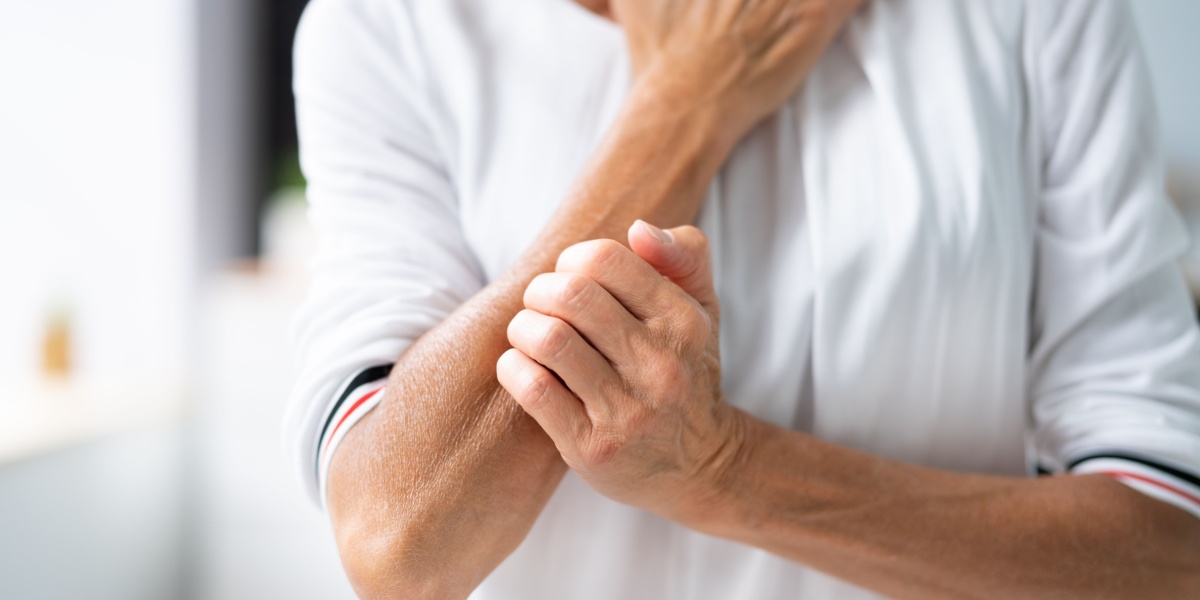One of the more distressing symptoms of methamphetamine misuse are so-called ‘meth mites.’ This psychological experience involves intense itchiness and the feeling that bugs are crawling on or under the skin. Repeated picking at the skin can easily lead to problematic sores and infections.
This information is not intended to replace professional medical advice. If you or your loved ones are worried about the impact of meth addiction, seek support from your healthcare provider.
- Meth mites describes the psychological sensation of bugs crawling under or on the skin that is associated with meth use. Repetitive picking and scratching due to meth mites can cause sores.
- People experiencing meth mites may have multiple scabs and wounds. These can easily become infected and cause localized or systemic illness.
- Good wound care and hygiene is important for preventing infection. Clinics and hospitals can provide wound treatment or antibiotics as necessary. Ultimately, treatment for meth addiction is vital for preventing future complications.

What are meth mites?
Meth mites (otherwise known as meth bugs or ice mites) are a type of touch hallucination where the person experiences the sensation of bugs crawling on or under the skin. Medically, this is called formication syndrome and is an intensely itchy and distressing experience.[1]
Meth bugs are a frequent experience for individuals who use meth regularly, with around 4 in 10 reporting experiencing this sensation. This number increases to 7 in 10 if the person has previously experienced some form of psychosis (hallucinations and delusions).[1]
Meth sores: Physical effects of meth bug hallucinations
Meth mites can often feel unbearable, and individuals affected often pick and scratch their skin to the point of causing wounds. These wounds can create indicative “pockmarks” and recurrent skin infections.
The risk of developing meth sores is increased by several factors: [1][2][3]
- Impaired immune system – Long-term meth use can significantly impact the ability of the immune system to function correctly. This leads to slow wound healing and an increased risk of infection.
- Poor hygiene – Individuals who use meth often struggle with self-neglect. Without regular cleaning, wounds can become an entry point for bacteria and debris.
- Injection skin and blood vessel damage – People who inject meth are at significant risk of introducing bacteria via the needle. Furthermore, damage caused to the blood vessels impairs circulation and wound healing.
- ‘Meth mouth’ - Rotten teeth are a common adverse effect of long-term meth use. This can lead to oral wounds, abscesses, and spreading infection.
Symptoms and appearance
The following signs and symptoms can point toward sores caused by meth mites: [1][4]
- Intense itching: The intense itching associated with meth mites leads to constant scratching that can damage the skin.
- Formication syndrome: This is the sensation that bugs are crawling on or under the skin, leading to obsessively picking at their skin in response to this feeling.
- Multiple scabs and open wounds: Constant scratching and skin picking can lead to multiple scabs and wounds across the face and body.
- Inflamed skin: If open wounds become infected, significant inflammation will cause areas that are painful, red, hot, and swollen.
- Abscesses and phlebitis: Painful skin lumps could point toward a walled-off infection under the skin (called an abscess) or painful inflammation of the veins (called phlebitis) if the person injects meth.
- Skin pits and pockmarks: After the skin heals, the wound-picking can leave several pits and pockmarks.
Long-term health risks of meth mites and sores
Alongside the immediate symptoms of meth mites and sores, there are several long-term effects that it is important to consider. [5]
- Recurrent infections: Skin infections (cellulitis) can easily persist and spread without proper treatment.
- Sepsis: Bacteria from a wound or skin infection can enter the bloodstream and cause a severe systemic infection called sepsis. This can be life-threatening and requires hospital treatment with strong intravenous (IV) antibiotics.
- Endocarditis: Infection in the bloodstream can reach the heart via blood circulation and cause infection within a heart valve, which is called endocarditis.
- Organ infection and damage: Repeated wound infection can increase the risk of developing severe infections of surrounding structures and other organs, such as the bones, lungs, and brain.
Treatment for meth sores
Effective treatment of meth sores involves multifaceted treatment that addresses the physical injury, associated infection, psychiatric causes, and methamphetamine addiction.
Wound care
One of the most essential steps in preventing and treating meth sores is to ensure wounds remain clean. Wounds and the surrounding skin should then be cleaned with soap and water or another antiseptic. After thorough cleaning, it is important to pat the skin dry and apply a sterile wound dressing. [6]
If the area becomes red, hot, or swollen, the wound may be infected, and you should seek immediate medical help.
Long-term treatment may be needed to repair skin that has become damaged over the course of a meth addiction.
Addiction support
Ultimately, meth mites and sores can only be fully addressed when the overarching meth addiction is treated. There are many support organizations and rehabilitation programs that aim to treat meth addiction. Take a look at Recovered's directory for more information on a provider near you.
Mental health support
Your healthcare provider may recommend psychiatric support to deal with meth mites. Sometimes, medications called antipsychotics may be prescribed to help reduce the distress caused by hallucinations and delusions. It is important to consider the presence of other co-occurring mental health conditions with substance use and establish appropriate treatment. [1]
Where to find treatment
Your local hospital or clinic can assess any sores and provide wound care and advice. If they think the wound is infected, they will prescribe antibiotics. If the infection is severe or there are signs of broader infection, you may be admitted to the hospital and given a course of IV antibiotics.
Help for meth addiction is available to you through your healthcare provider, support organizations such as Narcotics Anonymous, or one of the providers in our rehab directory.

-person-thumbnail.jpg?v=1758880627)


-guide-detail.jpg?v=1722501787)